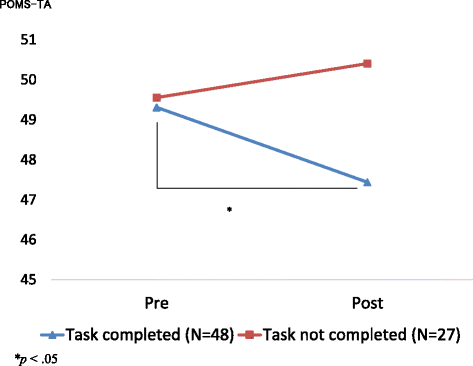Brief internet-based cognitive behavior therapy program with a supplement drink improved anxiety and somatic symptoms in Japanese workers
- PMID: 28874913
- PMCID: PMC5579873
- DOI: 10.1186/s13030-017-0111-y
Brief internet-based cognitive behavior therapy program with a supplement drink improved anxiety and somatic symptoms in Japanese workers
Abstract
Background: Self-help cognitive behavior therapy (CBT) is a useful approach for the treatment of psychological problems. Recent research on the effectiveness of self-help internet-based CBT (ICBT) indicates that the paradigm moderately improves psychological problems. Furthermore, previous studies have shown that food and drinks containing supplements improve various health conditions. We investigated the effect of a brief self-help ICBT administered with a supplement drink on psychological well-being and somatic symptoms.
Methods: In total, 101 healthy workers were enrolled in the 4-week ICBT program, which consisted of psychoeducation on stress management, behavior activation, and cognitive restructuring. The supplement soft drink was taken every day during the program. The participants were instructed to watch on-demand video clips and read the self-help guidebook and supporting comic strip weekly on the Internet or smartphone. The Japanese version of the Profile of Mood States (POMS) was administered before and after completion of the program. Scores on the POMS tension-anxiety (POMS-TA), depression (POMS-D), and fatigue (POMS-F) subscales were used to assess the effect of the program. Somatic symptoms were assessed using the Brief Job Stress Questionnaire.
Results: In total, 75 participants continued the program for 4 weeks; however, of those, 27 failed to complete all weekly tasks or meet the post-assessment deadlines. Therefore, the data of 48 participants were included in the analysis. Pre-post intervention comparisons using paired t-tests revealed significant improvement on the POMS-TA, but not the POMS-D or POMS-F subscales. Moreover, participants reported a significant reduction in the severity of low back pain.
Conclusion: Our brief intervention moderately improved anxiety levels and the symptom of low back pain. These findings suggest that the brief ICBT program is effective in non-patient populations. Future directions for brief ICBT are discussed.
Trial registration: This study was registered on February 10, 2016 at UMIN. The registration number is UMIN000020962.
Keywords: Cognitive behavior therapy; Internet; L-carnosine; Self-help; Workplace.
Conflict of interest statement
Ethics approval and consent to participate
This study was approved by the Institutional Review Board of Suntory Ltd. (ID: Kenko Cyo-jyu T-16-01). Before the start of the program, an informed consent session was held where the study purpose and procedures were explained, and participants provided written informed consent.
Consent for publication
Not applicable.
Competing interests
YN, JT, and KA were employees of Suntory Global Innovation Center Limited during the study period.
Publisher’s Note
Springer Nature remains neutral with regard to jurisdictional claims in published maps and institutional affiliations.
Figures


Similar articles
-
The effect for Japanese workers of a self-help computerized cognitive behaviour therapy program with a supplement soft drink.Biopsychosoc Med. 2017 Sep 19;11:23. doi: 10.1186/s13030-017-0109-5. eCollection 2017. Biopsychosoc Med. 2017. PMID: 28932258 Free PMC article.
-
Therapist-Assisted Internet-Based Cognitive Behavioral Therapy Versus Progressive Relaxation in Obsessive-Compulsive Disorder: Randomized Controlled Trial.J Med Internet Res. 2018 Aug 8;20(8):e242. doi: 10.2196/jmir.9566. J Med Internet Res. 2018. PMID: 30089607 Free PMC article. Clinical Trial.
-
Effects of an Internet-based cognitive behavioral therapy (iCBT) program in Manga format on improving subthreshold depressive symptoms among healthy workers: a randomized controlled trial.PLoS One. 2014 May 20;9(5):e97167. doi: 10.1371/journal.pone.0097167. eCollection 2014. PLoS One. 2014. PMID: 24844530 Free PMC article. Clinical Trial.
-
L-carnosine as an enhancer to computerized cognitive behaviour therapy in Japanese workers, an unjustified claim.Biopsychosoc Med. 2018 Sep 4;12:11. doi: 10.1186/s13030-018-0130-3. eCollection 2018. Biopsychosoc Med. 2018. PMID: 30202430 Free PMC article.
-
The Effectiveness of Unguided Internet-Based Cognitive Behavioral Therapy for Tinnitus for Patients with Tinnitus Alone or Combined with Hyperacusis and/or Misophonia: A Preliminary Analysis.J Am Acad Audiol. 2022 Jul;33(7-08):405-416. doi: 10.1055/a-2087-0262. Epub 2023 May 5. J Am Acad Audiol. 2022. PMID: 37146649 Free PMC article.
Cited by
-
Somatic manifestation of distress: clinical medicine, psychological, and public health perspectives.Biopsychosoc Med. 2017 Dec 18;11:33. doi: 10.1186/s13030-017-0119-3. eCollection 2017. Biopsychosoc Med. 2017. PMID: 29270213 Free PMC article. No abstract available.
-
A systematic realist synthesis of digital interventions for enhancing mental health at work: contexts, mechanisms, and outcomes.Int J Ment Health Syst. 2025 Jan 9;19(1):3. doi: 10.1186/s13033-024-00655-5. Int J Ment Health Syst. 2025. PMID: 39780192 Free PMC article. Review.
-
Cognitive-behavioral therapy for management of mental health and stress-related disorders: Recent advances in techniques and technologies.Biopsychosoc Med. 2021 Oct 3;15(1):16. doi: 10.1186/s13030-021-00219-w. Biopsychosoc Med. 2021. PMID: 34602086 Free PMC article. Review.
-
Five studies evaluating the impact on mental health and mood of recalling, reading, and discussing fiction.PLoS One. 2022 Apr 8;17(4):e0266323. doi: 10.1371/journal.pone.0266323. eCollection 2022. PLoS One. 2022. PMID: 35395034 Free PMC article.
References
LinkOut - more resources
Full Text Sources
Other Literature Sources

